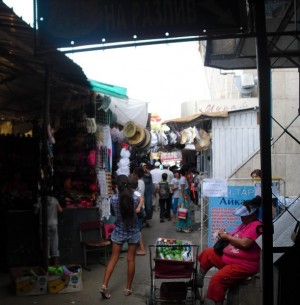24 hours in Bishkek
Bishkek, Kyrgyzstan. Half past noon, with a heat index well above 90 degrees Fahrenheit (32 degrees Celsius). My mission: to find a place to cool off, and fill my howling stomach. The only issue: I speak practically zero Kyrgyz, only know basic Russian, and don’t have a clue where I am. Dressed like a metrosexual version of Indiana Jones in a checkered green button-up shirt, khaki pants and over-the-top flat cap, I surveyed my surroundings. If this were a movie, it would be called “Benjamin Mack and the Kingdom of the Empty Gut.”
Bishkek is a relatively young city, founded in 1825 as a Khokand fortress and only acquiring its current name in 1991, mere months before Kyrgyzstan’s independence following the breakup of the Soviet Union. I was in the Osh Bazaar, one of the greatest marketplaces in all of Central Asia. The sprawling complex on the west side of the city is massive, but even that word does little justice for how big the place really is.
Labyrinthine, like a giant anaconda coiling itself around several city blocks, the Osh Bazaar is the type of place one thinks of when asked their ideal image of the Silk Road. Comparable to Bangkok’s Chatuchak weekend market or Tehran’s Grand Bazaar, it is one of the main entrepôts through which consumer goods from China arrive to shops and markets in Kazakhstan, Russia and Uzbekistan. The hodgepodge of exotic aromas wafting about is an olfactory fete: here one can smell lavender or thyme, the mustiness of hand-woven carpets, and the polish used on shoes slathered in the stuff. Name the country or product, and it can be found: clothing from Europe, electronics from Japan, CDs from South Korea, woodcrafts from Thailand, and anything and everything else. Shoppers charter buses from as far as Western Siberia to purvey the products on offer, many of which are sold in repurposed shipping containers that give the place a pop-up feel despite existing for decades, if not centuries. The number of languages one hears is a veritable Tower of Babel; though Russian and Kyrgyz may be the predominant languages of trade, snatches of Mandarin, Turkish, Hindi, Pashto, Dari, Farsi, Yakut, Mongolian and Kazakh can all be heard with the frequency one finds traditional Kyrgyz felt kalpak hats on offer.
But for all its dizzying array of items and sensual overload, it seemed to lack one vital component: food. For a cathedral of capitalism of this scale, why wasn’t there anything to eat?
I plunged deeper into the bazaar. Maybe further within there’d be a restaurant, food cart, produce seller or baker. Given the sheer size of the place, odds were there would be. The Osh Bazaar has a reputation for being a bit rougher than Bishkek’s other large public market, the Dordoy Bazaar. Like a black hole or pit of quicksand, it sucks one in with an inescapable pull; the incredibly tight spaces are more cramped than any New York or Tokyo subway, shoppers and shopkeepers more aggressive than any in Istanbul or Cairo. Winding through the maze, I was jostled by tiny elderly women hunched over as they dashed as if possessed from one stall to the other to barter for the best deals possible, pulled aside by eager salesmen offering trousers for 200 som (about $4.10), and accosted by curious fellow travelers surprised by the presence of a Westerner in the bazaar and eager to try on my hat and have a photo taken. But still nothing to eat, not even a table of nan bread or vegetables.
Left, right, left, left and right again; orienting oneself in the bazaar is as impossible a task as molecular displacement.
Kyrgyzstan, one of the world’s least-known countries, emerged following the collapse of the Soviet Union in 1991. During the Soviet period, most of the alpine nation — roughly 94 percent of which is covered by mountains — was off limits to outsiders. But Bishkek boasts outsiders galore — though many of them have differing views on what an “outsider” in a land rich in spiritualism and myth really is. One vendor, a sallow old woman missing more than a few teeth and who appeared to be an ethnic Russian, exploded in anger as I walked by, lifting a large glass over her head and banging it on a table forcefully while screaming something likely related to my disinterest in purchasing anything and/or decidedly out-of-place appearance amid the not uncommon number of people with talismans poking out from their shirts. She certainly wasn’t complimenting me on my hat.
Right, left, right, left, left. I was still lost amid the endlessly crisscrossing corridors mottled with specks of sunlight poking in through holes in corrugated roofing and town canvas. More jostling, more shouting.
(Article continued on next page)

